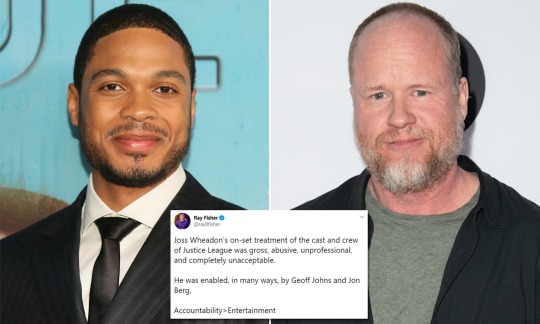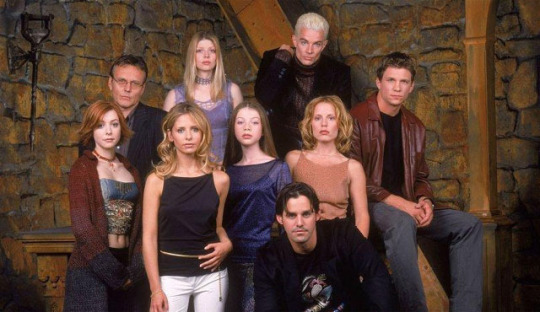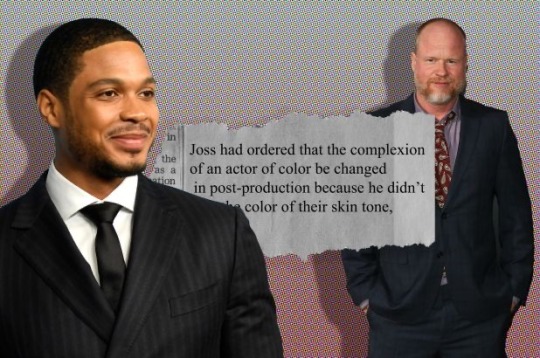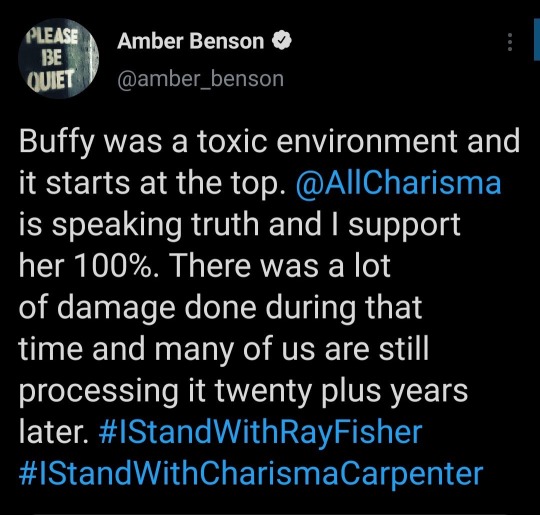#inversions are the 7th layer of hell
Explore tagged Tumblr posts
Text
I hate inversions

0 notes
Text
The Rise & Fall of Joss Whedon; the Myth of the Hollywood Feminist Hero
By Kelly Faircloth

“I hate ‘feminist.’ Is this a good time to bring that up?” Joss Whedon asked. He paused knowingly, waiting for the laughs he knew would come at the creator of Buffy the Vampire Slayer making such a statement.
It was 2013, and Whedon was onstage at a fundraiser for Equality Now, a human rights organization dedicated to legal equality for women. Though Buffy had been off the air for more than a decade, its legacy still loomed large; Whedon was widely respected as a man with a predilection for making science fiction with strong women for protagonists. Whedon went on to outline why, precisely, he hated the term: “You can’t be born an ‘ist,’” he argued, therefore, “‘feminist’ includes the idea that believing men and women to be equal, believing all people to be people, is not a natural state, that we don’t emerge assuming that everybody in the human race is a human, that the idea of equality is just an idea that’s imposed on us.”
The speech was widely praised and helped cement his pop-cultural reputation as a feminist, in an era that was very keen on celebrity feminists. But it was also, in retrospect, perhaps the high water mark for Whedon’s ability to claim the title, and now, almost a decade later, that reputation is finally in tatters, prompting a reevaluation of not just Whedon’s work, but the narrative he sold about himself.

In July 2020, actor Ray Fisher accused Whedon of being “gross, abusive, unprofessional, and completely unacceptable” on the Justice League set when Whedon took over for Zach Synder as director to finish the project. Charisma Carpenter then described her own experiences with Whedon in a long post to Twitter, hashtagged #IStandWithRayFisher.
On Buffy the Vampire Slayer and Angel, Carpenter played Cordelia, a popular character who morphed from snob to hero—one of those strong female characters that made Whedon’s feminist reputation—before being unceremoniously written off the show in a plot that saw her thrust into a coma after getting pregnant with a demon. For years, fans have suspected that her disappearance was related to her real-life pregnancy. In her statement, Carpenter appeared to confirm the rumors. “Joss Whedon abused his power on numerous occasions while working on the sets of ‘Buffy the Vampire Slayer’ and ‘Angel,’” she wrote, describing Fisher’s firing as the last straw that inspired her to go public.
Buffy was a landmark of late 1990s popular culture, beloved by many a burgeoning feminist, grad student, gender studies professor, and television critic for the heroine at the heart of the show, the beautiful blonde girl who balanced monster-killing with high school homework alongside ancillary characters like the shy, geeky Willow. Buffy was very nearly one of a kind, an icon of her era who spawned a generation of leather-pants-wearing urban fantasy badasses and women action heroes.

Buffy was so beloved, in fact, that she earned Whedon a similarly privileged place in fans’ hearts and a broader reputation as a man who championed empowered women characters. In the desert of late ’90s and early 2000s popular culture, Whedon was heralded as that rarest of birds—the feminist Hollywood man. For many, he was an example of what more equitable storytelling might look like, a model for how to create compelling women protagonists who were also very, very fun to watch. But Carpenter’s accusations appear to have finally imploded that particular bit of branding, revealing a different reality behind the scenes and prompting a reevaluation of the entire arc of Whedon’s career: who he was and what he was selling all along.
Buffy the Vampire Slayer premiered March 1997, midseason, on The WB, a two-year-old network targeting teens with shows like 7th Heaven. Its beginnings were not necessarily auspicious; it was a reboot of a not-particularly-blockbuster 1992 movie written by third-generation screenwriter Joss Whedon. (His grandfather wrote for The Donna Reed Show; his father wrote for Golden Girls.) The show followed the trials of a stereotypical teenage California girl who moved to a new town and a new school after her parents’ divorce—only, in a deliberate inversion of horror tropes, the entire town sat on top of the entrance to Hell and hence was overrun with demons. Buffy was a slayer, a young woman with the power and immense responsibility to fight them. After the movie turned out very differently than Whedon had originally envisioned, the show was a chance for a do-over, more of a Valley girl comedy than serious horror.

It was layered, it was campy, it was ironic and self-aware. It looked like it belonged on the WB rather than one of the bigger broadcast networks, unlike the slickly produced prestige TV that would follow a few years later. Buffy didn’t fixate on the gory glory of killing vampires—really, the monsters were metaphors for the entire experience of adolescence, in all its complicated misery. Almost immediately, a broad cross-section of viewers responded enthusiastically. Critics loved it, and it would be hugely influential on Whedon’s colleagues in television; many argue that it broke ground in terms of what you could do with a television show in terms of serialized storytelling, setting the stage for the modern TV era. Academics took it up, with the show attracting a tremendous amount of attention and discussion.
In 2002, the New York Times covered the first academic conference dedicated to the show. The organizer called Buffy “a tremendously rich text,” hence the flood of papers with titles like “Pain as Bright as Steel: The Monomyth and Light in ‘Buffy the Vampire Slayer,’” which only gathered speed as the years passed. And while it was never the highest-rated show on television, it attracted an ardent core of fans.
But what stood out the most was the show’s protagonist: a young woman who stereotypically would have been a monster movie victim, with the script flipped: instead of screaming and swooning, she staked the vampires. This was deliberate, the core conceit of the concept, as Whedon said in many, many interviews. The helpless horror movie girl killed in the dark alley instead walks out victorious. He told Time in 1997 that the concept was born from the thought, “I would love to see a movie in which a blond wanders into a dark alley, takes care of herself and deploys her powers.” In Whedon’s framing, it was particularly important that it was a woman who walked out of that alley. He told another publication in 2002 that “the very first mission statement of the show” was “the joy of female power: having it, using it, sharing it.”

In 2021, when seemingly every new streaming property with a woman as its central character makes some half-baked claim to feminism, it’s easy to forget just how much Buffy stood out among its against its contemporaries. Action movies—with exceptions like Alien’s Ripley and Terminator 2's Sarah Conner—were ruled by hulking tough guys with macho swagger. When women appeared on screen opposite vampires, their primary job was to expose long, lovely, vulnerable necks. Stories and characters that bucked these larger currents inspired intense devotion, from Angela Chase of My So-Called Life to Dana Scully of The X-Files.
The broader landscape, too, was dismal. It was the conflicted era of girl power, a concept that sprang up in the wake of the successes of the second-wave feminist movement and the backlash that followed. Young women were constantly exposed to you-can-do-it messaging that juxtaposed uneasily with the reality of the world around them. This was the era of shitty, sexist jokes about every woman who came into Bill Clinton’s orbit and the leering response to the arrival of Britney Spears; Rush Limbaugh was a fairly mainstream figure.

At one point, Buffy competed against Ally McBeal, a show that dedicated an entire episode to a dancing computer-generated baby following around its lawyer main character, her biological clock made zanily literal. Consider this line from a New York Times review of the Buffy’s 1997 premiere: “Given to hot pants and boots that should guarantee the close attention of Humbert Humberts all over America, Buffy is just your average teen-ager, poutily obsessed with clothes and boys.”
Against that background, Buffy was a landmark. Besides the simple fact of its woman protagonist, there were unique plots, like the coming-out story for her friend Willow. An ambivalent 1999 piece in Bitch magazine, even as it explored the show’s tank-top heavy marketing, ultimately concluded, “In the end, it’s precisely this contextual conflict that sets Buffy apart from the rest and makes her an appealing icon. Frustrating as her contradictions may be, annoying as her babe quotient may be, Buffy still offers up a prime-time heroine like no other.”
A 2016 Atlantic piece, adapted from a book excerpt, makes the case that Buffy is perhaps best understood as an icon of third-wave feminism: “In its examination of individual and collective empowerment, its ambiguous politics of racial representation and its willing embrace of contradiction, Buffy is a quintessentially third-wave cultural production.” The show was vested with all the era’s longing for something better than what was available, something different, a champion for a conflicted “post-feminist” era—even if she was an imperfect or somewhat incongruous vessel. It wasn’t just Sunnydale that needed a chosen Slayer, it was an entire generation of women. That fact became intricately intertwined with Whedon himself.
Seemingly every interview involved a discussion of his fondness for stories about strong women. “I’ve always found strong women interesting, because they are not overly represented in the cinema,” he told New York for a 1997 piece that notes he studied both film and “gender and feminist issues” at Wesleyan; “I seem to be the guy for strong action women,’’ he told the New York Times in 1997 with an aw-shucks sort of shrug. ‘’A lot of writers are just terrible when it comes to writing female characters. They forget that they are people.’’ He often cited the influence of his strong, “hardcore feminist” mother, and even suggested that his protagonists served feminist ends in and of themselves: “If I can make teenage boys comfortable with a girl who takes charge of a situation without their knowing that’s what’s happening, it’s better than sitting down and selling them on feminism,” he told Time in 1997.
When he was honored by the organization Equality Now in 2006 for his “outstanding contribution to equality in film and television,” Whedon made his speech an extended riff on the fact that people just kept asking him about it, concluding with the ultimate answer: “Because you’re still asking me that question.” He presented strong women as a simple no-brainer, and he was seemingly always happy to say so, at a time when the entertainment business still seemed ruled by unapologetic misogynists. The internet of the mid-2010s only intensified Whedon’s anointment as a prototypical Hollywood ally, with reporters asking him things like how men could best support the feminist movement.
Whedon’s response: “A guy who goes around saying ‘I’m a feminist’ usually has an agenda that is not feminist. A guy who behaves like one, who actually becomes involved in the movement, generally speaking, you can trust that. And it doesn’t just apply to the action that is activist. It applies to the way they treat the women they work with and they live with and they see on the street.” This remark takes on a great deal of irony in light of Carpenter’s statement.

In recent years, Whedon’s reputation as an ally began to wane. Partly, it was because of the work itself, which revealed more and more cracks as Buffy receded in the rearview mirror. Maybe it all started to sour with Dollhouse, a TV show that imagined Eliza Dushku as a young woman rented out to the rich and powerful, her mind wiped after every assignment, a concept that sat poorly with fans. (Though Whedon, while he was publicly unhappy with how the show had turned out after much push-and-pull with the corporate bosses at Fox, still argued the conceit was “the most pure feminist and empowering statement I’d ever made—somebody building themselves from nothing,” in a 2012 interview with Wired.)
After years of loud disappointment with the TV bosses at Fox on Firefly and Dollhouse, Whedon moved into big-budget Hollywood blockbusters. He helped birth the Marvel-dominated era of movies with his work as director of The Avengers. But his second Avengers movie, Age of Ultron, was heavily criticized for a moment in which Black Widow laid out her personal reproductive history for the Hulk, suggesting her sterilization somehow made her a “monster.” In June 2017, his un-filmed script for a Wonder Woman adaptation leaked, to widespread mockery. The script’s introduction of Diana was almost leering: “To say she is beautiful is almost to miss the point. She is elemental, as natural and wild as the luminous flora surrounding. Her dark hair waterfalls to her shoulders in soft arcs and curls. Her body is curvaceous, but taut as a drawn bow.”

But Whedon’s real fall from grace began in 2017, right before MeToo spurred a cultural reckoning. His ex-wife, Kai Cole, published a piece in The Wrap accusing him of cheating off and on throughout their relationship and calling him a hypocrite:
“Despite understanding, on some level, that what he was doing was wrong, he never conceded the hypocrisy of being out in the world preaching feminist ideals, while at the same time, taking away my right to make choices for my life and my body based on the truth. He deceived me for 15 years, so he could have everything he wanted. I believed, everyone believed, that he was one of the good guys, committed to fighting for women’s rights, committed to our marriage, and to the women he worked with. But I now see how he used his relationship with me as a shield, both during and after our marriage, so no one would question his relationships with other women or scrutinize his writing as anything other than feminist.”
But his reputation was just too strong; the accusation that he didn’t practice what he preached didn’t quite stick. A spokesperson for Whedon told the Wrap: “While this account includes inaccuracies and misrepresentations which can be harmful to their family, Joss is not commenting, out of concern for his children and out of respect for his ex-wife. Many minimized the essay on the basis that adultery doesn’t necessarily make you a bad feminist or erase a legacy. Whedon similarly seemed to shrug off Ray Fisher’s accusations of creating a toxic workplace; instead, Warner Media fired Fisher.

But Carpenter’s statement—which struck right at the heart of his Buffy-based legacy for progressivism—may finally change things. Even at the time, the plotline in which Charisma Carpenter was written off Angel—carrying a demon child that turned her into “Evil Cordelia,” ending the season in a coma, and quite simply never reappearing—was unpopular. Asked about what had happened in a 2009 panel at DragonCon, she said that “my relationship with Joss became strained,” continuing: “We all go through our stuff in general [behind the scenes], and I was going through my stuff, and then I became pregnant. And I guess in his mind, he had a different way of seeing the season go… in the fourth season.”
“I think Joss was, honestly, mad. I think he was mad at me and I say that in a loving way, which is—it’s a very complicated dynamic working for somebody for so many years, and expectations, and also being on a show for eight years, you gotta live your life. And sometimes living your life gets in the way of maybe the creator’s vision for the future. And that becomes conflict, and that was my experience.”
In her statement on Twitter, Carpenter alleged that after Whedon was informed of her pregnancy, he called her into a closed-door meeting and “asked me if I was ‘going to keep it,’ and manipulatively weaponized my womanhood and faith against me.” She added that “he proceeded to attack my character, mock my religious beliefs, accuse me of sabotaging the show, and then unceremoniously fired me following the season once I gave birth.” Carpenter said that he called her fat while she was four months pregnant and scheduled her to work at 1 a.m. while six months pregnant after her doctor had recommended shortening her hours, a move she describes as retaliatory. What Carpenter describes, in other words, is an absolutely textbook case of pregnancy discrimination in the workplace, the type of bullshit the feminist movement exists to fight—at the hands of the man who was for years lauded as a Hollywood feminist for his work on Buffy the Vampire Slayer and Angel.

Many of Carpenter’s colleagues from Buffy and Angel spoke out in support, including Buffy herself, Sarah Michelle Gellar. “While I am proud to have my name associated with Buffy Summers, I don’t want to be forever associated with the name Joss Whedon,” she said in a statement. Just shy of a decade after that 2013 speech, many of the cast members on the show that put him on that stage are cutting ties.
Whedon garnered a reputation as pop culture’s ultimate feminist man because Buffy did stand out so much, an oasis in a wasteland. But in 2021, the idea of a lone man being responsible for creating women’s stories—one who told the New York Times, “I seem to be the guy for strong action women”—seems like a relic. It’s depressing to consider how many years Hollywood’s first instinct for “strong action women” wasn’t a woman, and to think about what other people could have done with those resources. When Wonder Woman finally reached the screen, to great acclaim, it was with a woman as director.
Besides, Whedon didn’t make Buffy all by himself—many, many women contributed, from the actresses to the writers to the stunt workers, and his reputation grew so large it eclipsed their part in the show’s creation. Even as he preached feminism, Whedon benefitted from one of the oldest, most sexist stereotypes: the man who’s a benevolent, creative genius. And Buffy, too, overshadowed all the other contributors who redefined who could be a hero on television and in speculative fiction, from individual actors like Gillian Anderson to the determined, creative women who wrote science fiction and fantasy over the last several decades to—perhaps most of all—the fans who craved different, better stories. Buffy helped change what you could put on TV, but it didn’t create the desire to see a character like her. It was that desire, as much as Whedon himself, that gave Buffy the Vampire Slayer her power.
161 notes
·
View notes
Text
Walls Masterpost
It’s the 28th of pride month, and fitting to post this now. The soul of Walls is the unabashed, fierce, tender, and brave love of a man who has shown for years that he is proud. This album isn’t a cohesive story line, nor do I think it’s even the album Louis envisioned himself putting out. He only flirts with true indie music like that of his idols; Always You is a pop masterpiece, TOU is a ballad, and Perfect Now a love song in the style of Little Things. The album is a collection of letters each addressed to a singular recipient, personal, self-searching, blunt, too vulnerable to be easy listening (if you really listen). Walls shows us the scope of Louis’ capacity for love. It’s the culmination of years of pain, heartbreak, and hope, written with the raw honestly of an archeologist stumbling upon his own personal memoirs.
Please feel free to ask questions if any of the technical stuff is confusing, and remember these are my interpretations as a classically trained musician. I will use the name “Subject” for the implied “you” in each of Louis’ songs.
Kill My Mind: in F minor. The verses are i VII IV, the tiny bridge IV III I (?), and the chorus is VII IV I, repeat.
There are two oddities about this. First, in a natural minor key, the forth chord is minor (iv) but Louis keeps this B flat chord in major, changing the D flat to a D natural. Secondly, in the chorus, Louis changes from using a minor one chord to a major one. He raises the A flat to an A natural as he sings “Raise my body [A natural here] back to life.” This bit of text painting not only illustrates his words, but lends the song an off kilter feel, confusing the key signature between F minor and B flat Major (which has an A and D natural).
Kill My Mind is Louis’ only ‘drugs’ song on the album, and I say that both because the metaphor is obvious and because he uses that obvious metaphor to compare addiction to a relationship. It reminds me, lyrically, of Back To You, and, like that song, could easily be interpreted as about a controlling force in his life on whom he’s become dependent, or a lover.
Don’t Let It Break Your Heart: this is easily in the key of B flat Major. The verses are I IV vi 6/4 V 6/4, the bridge vi vi V IV vi V, the chorus same as the verses, I IV vi 6/4 V 6/4.
This is Louis’ most hopeful track, and is so clearly about grief. Much has been made of the first line “on our way to twenty seven” being a reference to the 27 Club, a cultural phenomenon of icons/musicians/artists that die at that age due to fame/high risk lifestyle, but Louis then says they’re “doing better,” implying that both he and Subject are in this category. The rest of the song is him counseling and comforting Subject, empathizing with the hurt of loss, encouraging Subject, “Don’t let it kill you even when it hurts like hell.” He knows this pain, knows it deep, and knows that it takes time to heal.
Two Of Us: IV I V iv V IV I V vi V. This progression is the same for both verses and chorus. The bridge is a bit hard to decipher as it moves in 3rds and not triads, something like IV V vi V vi V.
Not much needs to be said about this song. It’s Louis’ beautiful ode to his mom, and he sings it with incredible vulnerability and heart.
We Made It: this is the revolving door song. One progression is used, IV I V iii, and repeats from start to finish. It keeps reminding me of Coldplay.
What’s interesting is that each chord functions as the subdominant or leading chord of the next, basically spinning us ever forwards so we never stop on a tonic home base. The E flat IV chord leads to the B flat I, the B flat I then functions as a IV chord to the V chord (F Major), then the D minor III chord functions as a major VII leading to a I of E flat (the beginning IV chord we started with in B flat Major) and the cycle repeats.
Louis leaked part of this song several years ago, and a line about moonlight replaced the “met you at your uni” section, interestingly. “Playing something pop’y on the same four chords, used to worry bout it but I don’t no more.” Young love. He remembers how it tasted. Subject was high on what? Adrenaline? Orgasm? It’s a tender reminiscence with a hint of tragedy, “don’t know why they put this all on us when were so young.”
Too Young: in E Major, the verses and chorus are IV I V vi (the vi is omitted at the cadences), the bridge is vi I V IV I V.
Louis is once again looking back, regretful. Louis doesn’t speak in metaphors, the lyrics are to the point and precise. He’s hurt Subject, he’s given in to pressures, he’s cut subject off... the “2 years since I’ve seen your face” of course doesn’t fit the chronology of the album, but rather of his public life, as does the previous song’s line of “met you at your uni.” It’s interesting, then, that while Louis takes the blame for so much, he still says ‘we were too young’ and not ‘I was too young,’ implying that Subject was at least partly to blame for the hurt too, if only by fault of immaturity.
Walls: This is in B Major. The chord progression for verses is
vi I vi I, V [V7 with the melody note on the E natural] IV V V7 II IV i6 (passing chord)
chorus, IV I V I6, IV I V III6 vi V II6 Vi ii I (IV I passing chords)
bridge, IV vi V, IV vi V, Vi vi III6 vi V II (this holds over til chorus)
This is Louis’ tour de force. Walls is as complex as it is beautiful. His use of Major II chords, altered from a normal ii chord in Major key signatures, and his use of a Major III chord (which, again, is minor in Major key signatures) adds an unconventional twist. The opening and closing lyrics, “nothing wakes you up like waking up alone,” are set against a sparse vi I; but you see the vi chord doesn’t normally go to I, usually ii, IV, and V have that role, so by using a vi to I Louis is showing us the tonic alone, nothing ‘surrounding’ it. This song is so complex and layered, and I would argue it’s the one song besides OTB that is ripe for poetic interpretation; on first glance the lyrics seem so obvious, but there’s the music video to consider, the metaphor of him being left alone, high on a wall that has not fallen down, a blank name tag on his chest. The door opening to a desert on one side and a bullseye masquerade on the other has no happy implications, yet Louis has become a man through it all, he says, and he has no regrets about letting his walls crumble for love, damn the consequences he’s suffered.
Habit: in G Major, the verses are I ii IV I, the bridge vi V IV I vi V IV ii7, the chorus I ii IV (vi V added when leading to next verse). Interestingly, in the verse that says “come so far from Princess Park,” the repeated line “in front of me, in front of me” adds two chords to the verse, between the IV and I, a vi and V.
Like in too young, this is an apology, and Louis lays out his sins plainly. And while it’s unequivocal, we can see the extenuating circumstances: “took some time ‘cause I ran out of energy playing someone I heard I’m supposed to be.” There is no more damning line of lyrics. Louis has been exhausted holding some line, an invisible current through his music that he never truly addresses, yet always its there, a background character, a force of cruel divinity. “Don’t know why they put this all on us when were so young.” “I’m too far gone to pray.”
Always You: This song could conquer radio in half a heartbeat, given a chance. It’s in E Major, verses are I vi IV, chorus is I vi IV, the same.
This is world tour of missing Subject, this is Miss You but rephrased, reworked, gone from punk to pop princess. We have Amsterdam, Tokyo, LAX, Heathrow, which speak for themselves. “My baby,” Louis quotes over and over. He’s been “chasing a high,” and I’m reminded of the high in We Made It, “baby you were still high.” Orgasm? Adrenaline? Love?
Fearless: A minor. Verses, i VII VI (added VI VII when leading back to verse), bridge is i V VI (III VII passing chords can be heard) i V VI VII
Now the very short chorus (”fearless, fearless,”) is, if we stick to A minor, III, III4/2, i, VI. I think, however, that at this point the piece modulates, going from A minor to C Major, (A minor is the relative minor of C Major, which means that the two keys share a key signature and can go into and out of each other easily) making the progressions I I4/2 (4/2 is an inversion of a 7th chord) vi IV. Now to add complexity on top of that, having a I7 chord is incredibly unusual, so I wouldn’t label it that, I would label it a V4/2 of IV, meaning that C7 chord functions as a cadential chord leading to F, or the IV chord, of C Major. This is all rather complicated, but knowing how it was constructed shows the song’s complexity. The final “fearless, fearless” progression then is: I, V4/2 of IV, vi, VI.
In this song I believe Louis’ Subject is himself. it’s a song about fame and anxiety and the lost innocence (and gutsiness) of youth. It’s a brutal song that I doubt Louis would write to anyone besides himself given how he focuses solely on his own faults and doesn’t lay anything at the feet of his other Subjects. The laughing children heard fist and last are a cutting effect.
Perfect Now: D Major. Verses, I I7 [again this is technically a V7 of IV, and functions as that since it leads to IV] IV6/4 iv6/4
bridge, iii vi ii vi
chorus, IV V I IV V I, IV V I IV I
second bridge, V vi IV I, V vi IV vi (then to chorus)
This is a strange little song, perhaps its most unusual quirk being the switch from a Major IV chord to a minor iv chord in the verse. The Subject in this song loves to dance, and I’m reminded of KMM. Subject isn’t just not feeling pretty, they’re depressed, they are reticent to be looked upon (”don’t hide away”) they are a crown-less queen, and tears are the norm. Subject has a platform - everyone is looking at them - and is a scene stealer, charismatic without trying. I’ve attempted and failed to understand this song in any way other than that Subject is dealing with dysphoria, and that this is Louis’ ode to their perfection, an affirmation of an identity that perhaps can only be realized in private. It is in this interpretation that the Major to minor flip of the 4 chord makes me absolutely crumble into pieces.
Defenceless: C flat Major (a most unusual key for a pop song). Verses are I V6 vi IV, bridge IV vi I V, chorus is IV vi I V (the falsetto second bridge is the same)
Defenceless is Louis at his most honest. Who writes these lyrics in a pop song? “You don’t have to keep on being strong for me and you,” “just want to be loved by you,” “you don’t have a thing to prove,” “I’m too tired to be tough,” “Wish I didn’t need so much of you.” A moth to a flame is different from a moth to a light; immolation is a theme in love stories. This is too honest for a love song, and it feels intrusive just to listen. Louis has a deep love for Subject, an abiding care and need for them.
Only The Brave: E flat Major. Verse, I (IV I) IV I, I (IV I) IV I
Chorus is vi V IV I [ii iii IV V OR IV V IV V, I can’t determine because of the movement in 3rds] I
This song. I can only compare it to when I used to cry when I’d see speeches about gay love; I never understood why, but I just knew, in my heart, before my brain had figured it out yet, that I was the same. This song is that. It is so intrinsically gay, the metaphors are woven in every word, every nuance. Burn history, break rules, cry like a fool, close enough to touch... the church of burnt romances. “I’m too far gone to pray.” Love is only for the brave. Of course it takes a great deal of bravery to love anything completely, to face the prospect of loss knowing how that love will rip you apart. And in the end, some might say from the cradle to the grave you are ultimately alone. Yet Louis knows better than any that those you love are always with you, “even when I’m on my own, I know I won’t be alone.” I believe this song is Louis’ concluding thesis to an album filled to the brim with anecdotes of his own love, a gift to us speaking of the commonality he shares with the wider community, a history of brave love, of loneliness, of too many dying stars in the sky. The tall tales, only hello hello, no goodbye; we don’t focus on the goodbyes. We tell our stories with happy endings, but love, sometimes it doesn’t have those, for some of us it’s a solo song.
Louis Tomlinson, I’m sure there’s not a chance in a million you’ll ever read this but, if you do, I see you, we see you. You are so loved. Thank you for this album, thank you for giving us this gift of love. Continue your artistic journey and follow your heart. We’ll be here, because for us, it’s Always You.
356 notes
·
View notes
Note
Unless the US resorted to an all out nuclear attack, there is no way that we could be certain of taking out all of NK's nuclear weapons. Any such all out attack would result in many millions of casualties in both North Korea and South Korea and almost certainly in Japan, China and Russia. Due to the fact that those US nukes would have to be detonated on the ground, in order to destroy widespread and deeply buried underground fortifications, as airbursts wouldn't be effective against deep bunkers
the resulting radioactive fallout would be particularly nasty and widespread. Not only would all of Japan (With a population of 130 million) be at risk for lethal levels of fallout, so would all of the West Coast of the USA (Alaska, Washington State, Oregon and California), as well as the coastal areas of western Canada and Mexico. Additionally, all of the Pacific fisheries would become poisoned due to the fallout and would be rendered toxic and unusable for decades to come.
Then there is the issue of sparking off a direct nuclear conflict with China and Russia. Once again, the simple reality is that the USA does not have conventional weapons that are capable of taking out all of the NK military/nuclear fortifications in one single surgical strike.
Without diving into a full argument in favor of counter-force strike, allow me to illustrate just how incorrect these misconceptions are. This isn’t your fault - everything you typed I have seen expressed, verbatim, by journalists, academics, and other people who should damn well know better.
You have been lied to, deliberately and consistently.
Lie #1:
US nukes would have to be detonated on the ground, in order to destroy widespread and deeply buried underground fortifications, as airbursts wouldn't be effective against deep bunkers
Not if the B-61-12 is used, the latest modification of the B-61 nuclear freefall bomb to make it a precision-guided, earth-penetrating, low-yield bunker buster. The precision guidance (GPS/inertial) alone makes it far more effective, as doubling the accuracy of a weapon increases its destructive potential eightfold (a simple consequence of the inverse-square law.) The earth-penetrating ability increases the “shock coupling,” i.e. the kinetic energy transferred to the earth (to collapse deep bunkers like an “earthquake bomb” does,) and of course, the low yield greatly reduces the collateral damage and fallout effects. The only publicly disclosed data on the Mod-12 puts the maximum yield at 50 kilotons, but based on prior configurations of the B-61s “physics package,” the weapon probably has a variable yield ranging from 0.3kt to 50kt. On its lowest setting, the bomb will only have a yield of three hundred tons. A sub-kiloton yield. Especially at such low yields, the earth-penetrating nature of the weapon is likely to reduce fallout, especially when hitting hard rock (less loose soil to be blown into the air; only rock actually vaporized by the very small nuclear fireball would be put into the air.) This is hard to gauge, as no declassified equations exist for working out fallout from a shallow sub-surface detonation. In fact, the excellent nukemap.com cannot calculate fallout even for a surface burst, as its equations only cover detonations of a kiloton or over.
It should be noted that the B-61-12 is in qualification testing as we speak - the weapon is finished, and given the urgency of the current crisis, could reasonably be rushed into service in low numbers.
Lie #2:
Then there is the issue of sparking off a direct nuclear conflict with China and Russia.
Even ignoring the existence of the B-61-12 described above, this claim completely ignores the bomber-based leg of the American nuclear triad, which still operates the AGM-86 Air Launched Cruise Missile (variable yield of 5-150 kilotons) and the B-83 freefall bomb (variable yield up to 1.2 megatons,) both delivered by the B-52 strategic bomber - some of which are based on Guam (and have been since the early days of the Cold War.) The B-52 has had an unescorted deep-nuclear-strike penetration mission ever since the AGM-28 Hound Dog debeuted in 1960, a massive nuclear-armed cruise missile designed to simply vaporize SAM sites and entire Soviet fighter bases so the B-52s could reach their targets and deliver their heavy freefall bombs. The modern incarnation of this would involve B-52s carrying ALCMs or B-83s internally, and carrying MALD-J decoys and/or JASSM-ER stealth cruise missiles on their external pylons to jam, confuse, and outright destroy North Korea’s painfully antiquated air defense network before moving in to deliver their nuclear strikes. And this is without escort or assistance from fighter-bombers and/or OECM aircraft based in Japan, Okinawa or South Korea, which they would have.
It is possible - though extremely unlikely - that Russia or China would panic and assume that a low number of incoming ICBMs/SLBMs from America’s direction were actually aimed at them, and decide to commit suicide by launching a massive retaliatory attack even before the tracks of incoming warheads had been “firmed up” by radar (even though China doesn’t have a “launch-on-warning” policy.) It is not possible that they will interpret lumbering Cold-War era bomber aircraft a legitimate nuclear threat to their very capable, modern, and dense IADS - even the ALCM is a dated, non-stealth design. Even if they should construe these aircraft as “attacking them,” by sheer dint of their numbers and possible kiloton yield per aircraft alone it’d qualify as a tactical useage of nuclear weapons, not a strategic one demanding immediate massive retaliation.
There is absolutely no credible argument for the employment of tactical nuclear warheads against North Korea leading to a full-on strategic nuclear exchange between Russia/China and the United States, and anyone telling you such is a lying bastard trying to play on your emotions to avoid making a real argument.
Lie #3:
Once again, the simple reality is that the USA does not have conventional weapons that are capable of taking out all of the NK military/nuclear fortifications in one single surgical strike.
The hell we don’t.

Meet the AGM-158 JASSM (Joint Air-to-Surface-Standoff Missile), a fully stealthed air-launched cruise missile that also has an ER variant (a full 600nm range) and a penetrating warhead variant for hardened targets.
The B-1B “Lancer” can carry 24 of these weapons in its internal bomb-bays. The B-1B is an intercontinental capable bomber (with suitable tanker support.) 1/3rd of the currently active US fleet (20 aircraft) can thus deliver 480 of these weapons - in a non-stop round trip direct from Dyess Air Force Base, Texas, as they have done many times in sorties to Afghanistan and Iraq.
Estimates of DPRK Transporter-Erector-Launcher numbers range from 150 to 300. Even if every single one was located inside its own dispersal bunker, the JASSM would be more than capable of destroying it, as their penetration ability is enhanced by the ability to conduct a guided attack (i.e. a 90-degree dive with full engine power to enhance the kinetic penetration prior to detonation.) This is indeed the worst case scenario, as any TELs located in large facilities under mountains can be interdicted simply by collapsing the tunnel entrances with similar weaponry - a TEL cannot fire a ballistic missile though a hundred feet of solid rock, after all. This vulnerability is almost certainly why the DPRK is observably building individual dispersal bunkers in close proximity to probable (and in one case, identified) under-mountain SRBM facilities.
Note I have not touched on the TLAM-D Tomahawk and its Tactical Tomahawk Penetrator Variant warhead (which put those neat holes in the hardened shelters at Shayrat AFB,) which is carried in copious numbers by the warships of 7th fleet (and by the four converted Ohio-class boomers, each mustering a staggering 154 weapons, for a total of 616 Tomahawk missiles deliverable with complete surprise,) nor the B-2 Spirit stealth bomber (capable of delivering a pair of the uniquely powerful 30,000 pound GBU-57 “MOP” bunker-busters, among other weapons,) or B-52s (both capable of inter-continental attacks as well,) or utilizing F-35s and F-22s in the strike role (with the F-22 lobbing Small Diameter Bombs, themselves capable bunker-busters in their own right,) nor any of the tactical fighter-bomber assets already in-theater, including US Air Force F-16s and F-15s in South Korea, or Navy/Marine Hornet/Super Hornets in Japan and Okinawa, all of them capable of delivering standoff cruise missiles and the JSOW glide-bomb with either a submunition or BROACH penetrating warhead.
Even if one assumes utilization of in-theater airpower is limited by the need to hide preparations from espionage, it is foolish to claim that the United States does not have an overwhelming capacity to deliver ordinance in a SURPRISE, surgical attack, even against extensively hardened targets. The only real limit on the United States’s ability in this regard is locating the targets, but given the massive superiority in ISR assets deployed to the peninsula - including U-2S spy planes and RQ-170 stealth drones capable of operating in DPRK airspace with relative impunity, combined with the relatively compact dimensions of the Korean peninsula, this is hardly an insurmountable obstacle.
And then there is the simple fact we needn’t intercept every single missile launcher and/or WMD warhead before launch, as South Korea and Japan will both be defended by a tested, multi-layered ABM shield. South Korea is covered by the SM-3 (late exoatmospheric intercept), THAAD (very high altitude endo-atmospheric intercept,) the SM-2ER/SM-6 (mid-atmospheric terminal intercept) and Patriot PAC-3 MSE/ERINT (medium to low altitude terminal intercept.) Japan won’t benefit from THAAD, but has several of its own destroyers armed with the SM-3 and can thus provide more for its own defense - and North Korea has far fewer MRBM/IRBMs capable of ranging Japan in the first place, and they’re larger, easier-to-find targets to begin with, making it very unlikely they’ll preserve enough assets through the initial strike to overwhelm even our limited ABM capacity as it currently stands.
It Is All Bullshit, My Friend
This is just the tip of the iceberg. Much, much, much more goes into planning a war than just this; there’s logistics, turnaround time, the need for redundancy (multiple weapon strikes for a single target, weapon duds, necessary re-strikes, Bomb Damage Assessment, the difficulty of coordinating Time on Target, communicating with/preparing one’s allies without telegraphing the blow, and so on,) but that just goes to show the most basic claims against counter-force strike that you’ve been fed by the media and the academics outright ignore known, tested military capabilities. This goes beyond saying “we can’t find TELs because we couldn’t do it 27 years ago in Desert Storm.” It requires ignoring seventeen years of hunting down elusive enemies in the mountainous and heavily-tunneled terrain of Afghanistan. This level of ignorance is willful and deliberate. When the existence of entire classes of weaponry and indeed, the staggeringly vast power-projection/deep strike ability of the United States is flatly and out-right ignored, one may well ask if a deliberate attempt to influence public opinion via lies (of omission or otherwise) is underway.
None of this means that I am right, of course - that argument will have to stand on its own merits. But I can assure you that the arguments you’ve been fed are laughably, blatantly wrong.
7 notes
·
View notes